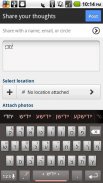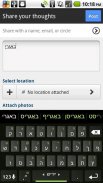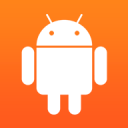




Yiddish Keyboard Plugin

Descripción de Yiddish Keyboard Plugin
Yiddish Dictionary plugin for Multiling O Keyboard autocorrect and word prediction
Instruction:
⑴ Install this plugin and Multiling O Keyboard. https://play.google.com/store/apps/details?id=kl.ime.oh
⑵ Run O Keyboard and follow its setup guide.
⑶ Slide space bar to switch languages.
If you have font issue, read this: <a href="https://www.google.com/url?q=https://www.google.com/url?q%3Dhttp://honsoapps.appspot.com/1/ma.html%26sa%3DD%26usg%3DAFQjCNG71Nl5i6QMcdEZvU1BqM2L70OWlQ&sa=D&usg=AFQjCNHJAfktVVilzCrduIwvK96EQvYRGw" target="_blank">http://honsoapps.appspot.com/1/ma.html</a>
Wikipedia:
Yiddish (ייִדיש, יידיש or אידיש, yidish/idish, literally "Jewish") is the historical language of the Ashkenazi Jews. It originated during the 9th century in Central Europe, providing the pre-existing language of the nascent Ashkenazi community with an extensive Germanic based vocabulary. Yiddish is written with a fully vocalized alphabet based on the Hebrew script.
The earliest surviving references date from the 12th century and call the language לשון־אַשכּנז (loshn-ashknez = "language of Ashkenaz") or טײַטש (taytsh), a variant of tiutsch, the contemporary name for Middle High German. In common usage, the language is called מאַמע־לשון (mame-loshn, literally "mother tongue"), distinguishing it from Hebrew and Aramaic, which are collectively termed לשון־קודש (loshn-koydesh, "holy tongue"). The term "Yiddish" did not become the most frequently used designation in the literature until the 18th century. In the late 19th and into the 20th century the language was more commonly called "Jewish", especially in non-Jewish contexts, but "Yiddish" is again the more common designation.
Modern Yiddish has two major forms. Eastern Yiddish is far more common today. It includes Southeastern (Ukrainian–Romanian), Mideastern (Polish–Galician–Eastern Hungarian), and Northeastern (Lithuanian–Belarusian) dialects. Eastern Yiddish differs from Western both by its far greater size and by the extensive inclusion of words of Slavic origin. Western Yiddish is divided into Southwestern (Swiss–Alsatian–Southern German), Midwestern (Central German), and Northwestern (Netherlandic–Northern German) dialects. Yiddish is used in a large number of Orthodox Jewish communities worldwide and is the first language of the home, school, and in many social settings among most Hasids. Yiddish is also the academic language of the study of the Talmud according to the tradition of the Lithuanian yeshivas.
The term Yiddish is also used in the adjectival sense, synonymously with Jewish, to designate attributes of Ashkenazi culture (for example, Yiddish cooking and Yiddish music).[4]
</div> <div jsname="WJz9Hc" style="display:none">Yiddish plugin para MultiLing O autocorrección Teclado y predicción de palabras
Instrucción:
⑴ Instalar este plugin y MultiLing O teclado. https://play.google.com/store/apps/details?id=kl.ime.oh
⑵ Run O Teclado y seguir su guía de configuración.
⑶ barra espaciadora para cambiar de diapositiva idiomas.
Si tiene un problema de la fuente, lea esto: <a href="https://www.google.com/url?q=http://honsoapps.appspot.com/1/ma.html&sa=D&usg=AFQjCNG71Nl5i6QMcdEZvU1BqM2L70OWlQ" target="_blank">http://honsoapps.appspot.com/1/ma.html</a>
Wikipedia:
Yídish (ייִדיש, יידיש o אידיש, yidish / idish, literalmente "judío") es la lengua histórica de los Judios Ashkenazi. Se originó en el siglo noveno en Europa Central, que proporciona el lenguaje preexistente de la comunidad Ashkenazi naciente con un vocabulario extenso basado germánica. Yiddish se escribe con un alfabeto totalmente vocalizado basado en la escritura hebrea.
Las referencias más antiguas que sobreviven datan del siglo 12 y llaman la lengua לשון-אַשכּנז (ashknez loshn = "lengua de Askenaz") o טייַטש (Taytsh), una variante de tiutsch, el nombre contemporáneo de alto alemán medio. En el uso común, el lenguaje se llama מאַמע-לשון (mame-loshn, literalmente "lengua materna"), distinguiéndola de hebreo y arameo, que se denominan colectivamente לשון-קודש (koydesh loshn, "lengua sagrada"). El término "Yiddish" no se convirtió en la denominación de uso más frecuente en la literatura hasta el siglo 18. A finales del 19 y en el siglo 20 el lenguaje fue más comúnmente llamado "judío", especialmente en contextos que no son judíos, pero "yiddish" es de nuevo la denominación más común.
Yiddish moderno tiene dos formas principales. Yiddish oriental es mucho más común hoy en día. Incluye sudeste (ucraniano-rumano), Mideastern (polaco-gallego-oriental de Hungría) y Noreste (lituano-bielorrusas) dialectos. Yiddish oriental difiere del occidental tanto por su mucho mayor tamaño y por la amplia inclusión de palabras de origen eslavo. Yiddish occidental se divide en sudoeste (Swiss-alsaciano-Sur de Alemania), del Medio Oeste (Central alemán), y Northwestern dialectos (el neerlandés-norte de Alemania). Yiddish se utiliza en un gran número de comunidades judías ortodoxas de todo el mundo y es el primer idioma del hogar, la escuela, y en muchos entornos sociales entre la mayoría de hasidas. Yiddish es también el lenguaje académico del estudio del Talmud de acuerdo a la tradición de la yeshivas lituano.
El término yiddish también se utiliza en el sentido de adjetivo, como sinónimo de judío, para designar los atributos de la cultura ashkenazi (por ejemplo, la cocina y la música Yiddish Yiddish). [4]</div> <div class="show-more-end">


























